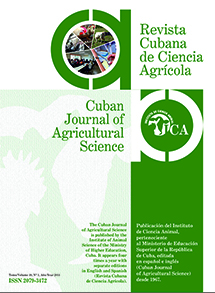Quality of three Brachiaria varieties in Guayas area, Ecuador
Contenido principal del artículo
Resumen
Using a random block design with factorial arrangement (3x3) with five replications, the quality of Brachiaria decumbens, Brachiaria brizantha and Brachiaria decumbens x Brachiaria ruziziensis cv. Mulato I at different regrowth ages (21, 42 and 63 days) were evaluated in Guayas area, Ecuador. The yields of total dry matter, biomass, leaves and stems were determined; as well as the plant height, length and width of leaves, the contents of DM, CP, NDF, ADF, ADL, cellulose (Cel), hemicellulose (Hcel),
cellular content (CC), P, Ca, ash, OM, DMD, OMD, ME, LNE and relations leaf-stem, NDF-N and ADF-N. There was significant interaction (P <0.0001) between the varieties and the regrowth age for all the studied indicators. The highest DM and biomass yields were obtained in Mulato I at 63 days of regrowth (1.59 and 5.23 t/ha, respectively).The CP and CC decreased with the maturity of the plant and the best values were obtained in Mulato
I at 21 days of regrowth (15.74 and 73.45 %, respectively), while the components of the cell wall increased with age and Brachiaria decumbens showed the highest values. There was variability in terms of the varieties in the studied indicators, with the best general performance for Mulato I. In this study the variability of the nutritional quality was showed by the interaction between the variety and the forage maturity, determined, among other aspects, by the decrease of digestibilities and the energy contribution, as well as increases of the relations NDF/N, ADF/N, it is important to highlight that the biomass production, total yields of leaves
and stems, in addition to the morphological indicators height, number of leaves, length and width showed the best results in Mulato I at 63 days.
Key words: quality, regrowth age, Brachiaria, digestibility, energy
cellular content (CC), P, Ca, ash, OM, DMD, OMD, ME, LNE and relations leaf-stem, NDF-N and ADF-N. There was significant interaction (P <0.0001) between the varieties and the regrowth age for all the studied indicators. The highest DM and biomass yields were obtained in Mulato I at 63 days of regrowth (1.59 and 5.23 t/ha, respectively).The CP and CC decreased with the maturity of the plant and the best values were obtained in Mulato
I at 21 days of regrowth (15.74 and 73.45 %, respectively), while the components of the cell wall increased with age and Brachiaria decumbens showed the highest values. There was variability in terms of the varieties in the studied indicators, with the best general performance for Mulato I. In this study the variability of the nutritional quality was showed by the interaction between the variety and the forage maturity, determined, among other aspects, by the decrease of digestibilities and the energy contribution, as well as increases of the relations NDF/N, ADF/N, it is important to highlight that the biomass production, total yields of leaves
and stems, in addition to the morphological indicators height, number of leaves, length and width showed the best results in Mulato I at 63 days.
Key words: quality, regrowth age, Brachiaria, digestibility, energy
Detalles del artículo
Cómo citar
Reyes-Pérez, J. J., Méndez-Martínez, Y., Luna-Murillo, R. A., Verdecia, D. M., Macias-Pettao, R., & Herrera, R. S. (2019). Quality of three Brachiaria varieties in Guayas area, Ecuador. Cuban Journal of Agricultural Science, 53(2). Recuperado a partir de https://mail.cjascience.com/index.php/CJAS/article/view/888
Sección
Ciencia de los pastos y otros cultivos
Aquellos autores/as que tengan publicaciones con esta revista, aceptan los términos siguientes:
- Los autores/as conservarán sus derechos de autor y garantizarán a la revista el derecho de primera publicación de su obra, el cuál estará simultáneamente sujeto a la Licencia Creative Commons Attribution-NonCommercial 4.0 International (CC BY-NC 4.0) que permite a terceros compartir la obra siempre que se indique su autor y su primera publicación esta revista. Bajo esta licencia el autor será libre de:
- Compartir — copiar y redistribuir el material en cualquier medio o formato
- Adaptar — remezclar, transformar y crear a partir del material
- El licenciador no puede revocar estas libertades mientras cumpla con los términos de la licencia
Bajo las siguientes condiciones:
- Reconocimiento — Debe reconocer adecuadamente la autoría, proporcionar un enlace a la licencia e indicar si se han realizado cambios. Puede hacerlo de cualquier manera razonable, pero no de una manera que sugiera que tiene el apoyo del licenciador o lo recibe por el uso que hace.
- NoComercial — No puede utilizar el material para una finalidad comercial.
- No hay restricciones adicionales — No puede aplicar términos legales o medidas tecnológicas que legalmente restrinjan realizar aquello que la licencia permite.
- Los autores/as podrán adoptar otros acuerdos de licencia no exclusiva de distribución de la versión de la obra publicada (p. ej.: depositarla en un archivo telemático institucional o publicarla en un volumen monográfico) siempre que se indique la publicación inicial en esta revista.
- Se permite y recomienda a los autores/as difundir su obra a través de Internet (p. ej.: en archivos telemáticos institucionales o en su página web) antes y durante el proceso de envío, lo cual puede producir intercambios interesantes y aumentar las citas de la obra publicada. (Véase El efecto del acceso abierto).
